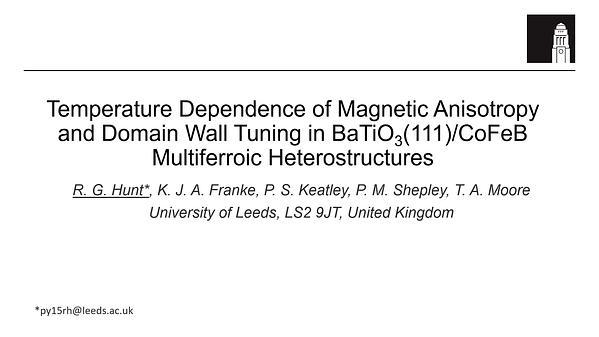Would you like to see your presentation here, made available to a global audience of researchers?
Add your own presentation or have us affordably record your next conference.
The angle dependence of field-induced switching was investigated in magnetic tunnel junctions (MTJ) with in-plane magnetization and a pinned synthetic antiferromagnet reference layer. 60 nm x 90 nm elliptical nanopillars were patterned from a film stack of SiOx/Ta (5)/CoFeB (2.5)/MgO (1)/CoFeB (2.5)/Ru (0.85)/CoFe (2.5)/IrMn (8)/Ru (10), (units in nm).
The tunnel magnetoresistance (TMR) was measured while the external field was applied at an angle θ, varying from 0° to 180° relative to the major axis of the ellipse (MAE), as shown in the inset of Fig.1. The relative angle between the free layer magnetization and the MAE, φ, was calculated from the TMR using an empirical cosine relation. Single sharp switches are seen when the field was applied along the MAE, but even with small deviations, reversal occurred through an intermediate state. Fig.1 shows a representative hysteresis loop measured at θ = 20°.
To determine the magnetization direction at different points in the hysteresis loop, the energy landscape was modeled in terms of the effective shape anisotropy field, the external magnetic field, and the SAF stray field. Using an 8 Oe shape anisotropy effective field and the 26 Oe SAF stray field strength estimated from the loop shift, the magnetization direction as a function of the external field magnitude and direction was reconstructed. Fig.2 shows the energy diagrams of the device at the critical fields. Near 26 Oe the barrier between the two lowest energy states is low, consistent with the telegraphing observed in Fig. 1. Intentional misalignment of the SAF and shape anisotropy fields has potential for development of faster probabilistic spintronic devices 1.
References 1. H. Chen, et al., Appl. Phys. Lett. 120, 212401 (2022).

